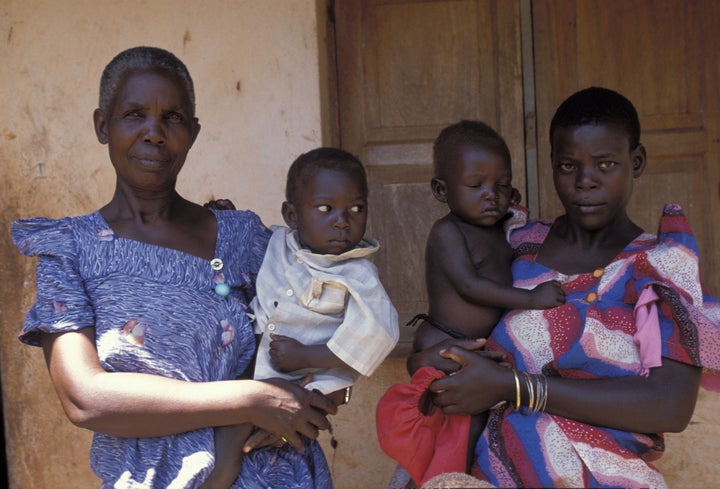
A few weeks ago, I introduced Huffington Post readers to a group of important diseases that most had never heard of -- neglected tropical diseases (NTDs). In that piece, I mentioned one disease that has a particularly devastating impact on girls and women in developing countries -- female genital schistosomiasis (FGS).
Schistosomiasis, also known as bilharzia or "snail fever," is a parasitic disease carried by fresh water snails. It is transmitted by contact with contaminated fresh water, so swimming, bathing, fishing and even domestic chores such as laundry and herding livestock can put people at risk of contracting the disease. Schistosomiasis infects more than 400 million people, mostly in sub-Sarahan Africa, where it is one of the most common parasitic infections on the continent.
But one form of the disease has particular repercussions for women and their health and reproductive systems -- FGS. It causes horrific pain and bleeding in the uterus, cervix and lower genital tract, not to mention social stigma and depression. Right now, more than 100 million women and girls in Africa could suffer from this form of schistosomiasis.
Unfortunately, the medical research community has much to learn about the disease. If medical students or young physicians happen to learn anything at all about schistosomiasis during their training (which they often do not), they discover it is an important parasitic infection affecting the bladder and sometimes the kidney. For decades, not many health care providers made the effort to study the total impact of schistosomiasis. We have only recently discovered that the same infections that can occur in the urinary tract are also found in the uterus, cervix and lower genital tracts in women and girls. Recent studies conducted by physicians from the University of Oslo and Weil Cornell Medical College confirm the lesions and tenderness caused by FGS lead to bleeding on contact -- causing a constant, severe pain that can be exacerbated during work, chores or intercourse.
Even worse, those same lesions provide conduits for the HIV virus to enter and infect women already suffering from FGS. Doctors from Oslo and Cornell have independently confirmed that these women have a 3-4 fold increase in the risk of acquiring HIV/AIDS. Not surprisingly, maps of the distribution of schistosomiasis and HIV/AIDS in Africa reveal extensive overlap in southern Africa, especially in Mozambique, South Africa, Tanzania and Zimbabwe.
The good news is that there is a low-cost drug, called praziquantel, which may prevent FGS and therefore also serve as a low-cost AIDS prevention strategy if it is administered annually to African girls and women beginning in their school-aged years. Currently, praziquantel is made generically and is available for 8 cents a tablet -- often two or three tablets administered at one time can help prevent FGS. In an earlier article published in the Public Library of Science I described this approach as "Africa's 32-cent solution for HIV/AIDS." Later in The Lancet ("Africa is desperate for praziquantel') my colleagues and I made an urgent plea to make praziquantel freely available. In response, Merck Serono, a division of the German pharmaceutical company Merck KgaA, committed to donating 250 million tablets in a January 30, 2012 announcement in London.
Given the links between female genital schistosomaisis and HIV/AIDS, I have argued that large-scale AIDS treatment programs such as the U.S. President's Emergency Plan for AIDS Relief (PEPFAR) and the Global Fund to Fight AIDS, Tuberculosis and Malaria (GFATM) should also embrace annual praziquantel treatments. Simultaneously, USAID and the British Department for International Development (DFID) have begun to support programs of praziquantel mass treatment for schistosomiasis control, along with private donations.
Yet another added measure would be to develop a true vaccine to prevent schistosomaisis. Currently, several such vaccines are under development, including one at the Institut Pasteur in Lille and the other at the Sabin Vaccine Institute and Texas Children's Hospital Center for Vaccine Development. These technologies could eventually lead to the elimination of schistosomaisis.
For too long we have allowed millions of girls and women to suffer from female genital schistosomaisis. We may now be at the beginning of the end of this disease, provided we can scale up schistosomiasis control efforts in addition to making a successful schistosomiasis vaccine.
To learn more or to get involved, please visit www.END7.org and together we can see the end of these diseases of poverty.
Peter Hotez M.D. Ph.D. is president of the Sabin Vaccine Institute and director of the Sabin Vaccine Institute and Texas Children's Hospital Center for Vaccine Development, and dean of the National School of Tropical Medicine at Baylor College of Medicine.